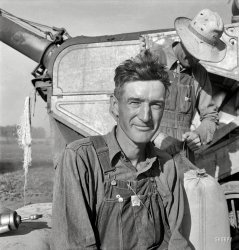
MAY CONTAIN NUTS

Search Shorpy
SHORPY ART

Framed or unframed, desk size to sofa size, printed by us in Arizona and Alabama since 2007. Explore now.
Join and Share
Ad-Free Shorpy
Shorpy is funded by you. Patreon contributors get an ad-free experience.
Learn more.

Recent comments
- Alas, hidden from view
- Exclusive pump
- Details, Details
- What's that building to the left of the tower?
- Coal Barges
- Bromo-Seltzer
- Inner harbor
- The Basin
- What a headache!
- Giant stepladder?
- Baldwin 62303
- Baldwin VO-1000
- Cold
- No expense spared
- Tough Guys
- Lost in Toyland
- And without gloves
- If I were a blindfolded time traveler
- Smoke Consumer Also Cooks
- Oh that stove!
- Possibly still there?
- What?!?
- $100 Reward
- Freeze Frame
- Texas Flyer wanted
- Just a Year Too Soon
- WWII -- Replacing men with women at the railroad crossing.
- Yes, Icing
- You kids drive me nuts!
- NOT An Easy Job
Member Photos
The Shorpy
Print Emporium
Print Emporium
Search Shorpy
Search results -- 30 results per page
- Pontiac Nation: 1928
- ... Indian trade blankets made by Pendleton woolen mills in Oregon (the two on the right are definitely Pendleton patterns from that era) ... Posted by Dave - 10/27/2019 - 3:25pm -
![Pontiac Nation: 1928 A scene that would no doubt bring a tear to Chief Pontiac's eye.
San Francisco in 1928. "Scouts in Indian costume with Pontiac autos." Junior G-men by the looks of it. 8x10 inch nitrate negative. View full size.
Why all the San Francisco Car Pix?How does Shorpy come by so many car pictures from the San Francisco Bay Area?
[He bought them from the estate of a lady who collected them. - Dave]
Indian trade blanketsThose costumed Scouts are sporting Indian trade blankets made by Pendleton woolen mills in Oregon (the two on the right are definitely Pendleton patterns from that era) and others. They were traded to the Indians in early days, but Pendleton kept making them to the present day. The older ones, like these, are pretty valuable. I have one from 1930 with the original tag and a hand sewn tag with the owner's name, who apparently took it to camp or college.
PontiacsWow! Can you imagine the outrage today over something like this? And we thought the Washington Redskins stirred it up.
Companion CarThe first Pontiacs were built in 1926, as a "companion make" to the Oakland automobile. Oaklands were built from 1901 to 1931, until Pontiacs began to outsell them by a wide margin, then GM phased the Oakland out in favor of the Pontiac. Of course, now the PMD itself is now history.
Probably Not Boy ScoutsJudging from the "G" on the hats and the triangular shaped patch on one boy's shoulder, my guess is that these are Indian Guides, an organization sponsored by the YMCA. The organization still exists, but within the last few years has shed the name and is now known as "Adventure Guides."
[The triangle is similar to the Scouts' current "First Aider" badge. We also have a Cub Scouts insignia. - Dave]
Order of the ArrowThey are definitely Boy Scouts, just look at the uniforms. The older guys are likely members of Order of the Arrow, which is still functioning. I was made a member when I was a Scoutmaster in 1983.
(The Gallery, Boy Scouts, Cars, Trucks, Buses, Native Americans, San Francisco)](https://www.shorpy.com/files/images/SHORPY-195-01.thumbnail.jpg)
- Shooting Crater Lake: 1975
- ... aiming my Nizo Super-8 movie camera across the waters of Oregon's Crater Lake. I'm on a trip with my brother and my friend who took this ... Posted by tterrace - 07/11/2015 - 4:13pm -
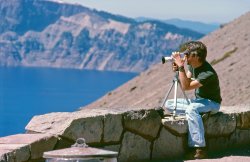
- Fancy Cakes: 1910
- ... it?
Bumpy handrails I took a tour of the Pendleton Oregon underground city, our tour guide told us that handrails like these ... Posted by Dave - 08/12/2013 - 10:49am -
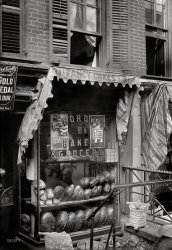
- Made in the Shade: 1941
- ... 1941. Youngsters at the Fourth of July picnic in Vale, Oregon. 35mm nitrate negative by Russell Lee for the Farm Security ... Posted by Dave - 01/08/2008 - 12:41pm -
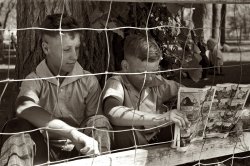
- Hanging Out: 1939
- ... the family first came." Willow Creek area, Malheur County, Oregon. Medium-format negative by Dorothea Lange for the Farm Security ... Posted by Dave - 08/15/2009 - 10:22pm -
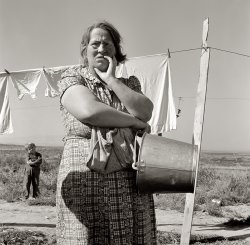
- Iron Dragon: 1943
- ... few weekends as the HOLIDAY EXPRESS, here in Portland, Oregon.
Along with SP #4449, SP&S #770 is one of two historic steam ... Posted by Dave - 11/24/2013 - 8:35am -
![Iron Dragon: 1943 March 1943. "On the Atchison, Topeka & Santa Fe between Chicago and Chillicothe, Illinois." Another of the many photos by Jack Delano documenting his trip on a freight train from Chicago to California. View full size.
For those of us in the North CountryIt's a beautiful picture, but I'm going to be looking at landscapes like this for the next five months.
Wonderful, Jack!I just can not get enough of these terrific train pictures.
Which reminds me -- anything ever from Lucius Beebe?
[The occasional order for caviar and Champagne. - Dave]
Ahhh, that's Lucius alright..... from ''The Pump Room''?
#3259was 2-8-2 stationed at Chillicothe that met its fate in 1952. You may have driven around in a car with parts made from this beauty.
Old Tea kettlesSP&S #700 is getting eready to make some runs the next few weekends as the HOLIDAY EXPRESS, here in Portland, Oregon.
Along with SP #4449, SP&S #770 is one of two historic steam engines tha operate out of Portland, with a third one currently being restored to running condition.
There is nothing like the sound of a Steam train and whistle.
Is she "carrying green?"I'm referring to the flags that can be seen on either side atop the smoke box. Very difficult to tell in an old black&white photo. They may be very dirty white ones, however.
Green signified "extra section(s) to follow," meaning the train was long enough that it was divided into more than one train. White flags meant it was "running extra" as an unscheduled train not listed on the timetable.
Considering the date, March 1943, at the height of WWII, either designation was possible. The railroads were doing yoeman service hauling troops and freight for the war effort!
(The Gallery, Jack Delano, Railroads)](https://www.shorpy.com/files/images/SHORPY_8d26327a.thumbnail.jpg)
- Wyoming: 1940
- ... of Nowhere Years ago, on a motorcycle ride in eastern Oregon on US 395 between Burns and John Day, I found a similar spot. Stopped, ... Posted by Dave - 01/29/2018 - 9:55am -
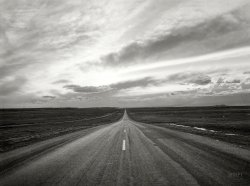
- Our New Life: 1936
- ... Yakima, and my mother was from Walla Walla, down near the Oregon state line. Their families weren't totally unaffected by the depression, ... Posted by Dave - 07/12/2014 - 2:40pm -
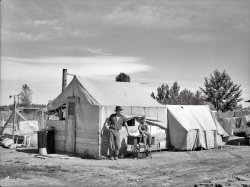
- Cow Hollow: 1939
- ... Sam Cates, wife of Cow Hollow farmer. Malheur County, Oregon." View full size. Medium-format nitrate negative by Dorothea Lange. ... Posted by Dave - 04/13/2008 - 12:18pm -
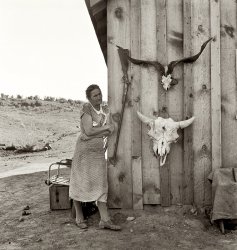
- Desperado: 1941
- ... cap guns and fireworks for sale, Fourth of July, Vale, Oregon." 35mm acetate negative by Russell Lee for the Farm Security ... Posted by Dave - 09/13/2020 - 12:15pm -
![Desperado: 1941 July 1941. "Store with cap guns and fireworks for sale, Fourth of July, Vale, Oregon." 35mm acetate negative by Russell Lee for the Farm Security Administration. View full size.
Regrets"If only I hadn't spent all my money on licorice twists!"
I give upWhat in the world is on the front of this young man?
[A dog. - Dave]
Cap RollsThe "ammo" for a cap gun is a roll of red paper with small amounts of explosive powder. The smell of the smoke emitted along with the shot was part of the experience.
"A dog"A plaster dog, at that. I bet his mother just loved it! Well, at least it didn't need to be housebroken.
HubleyA first-rate brand. Ask the kid who owned one.
Very nice inventory, I am partial to the pearl handled 1911.
General Patton would not approve ... of pearl grips on a cap gun. And while I like a good Hubley, I'm a Fanner 50 man.
(The Gallery, July 4, Kids, Russell Lee, Stores & Markets)](https://www.shorpy.com/files/images/SHORPY-8a30286a.thumbnail.jpg)
- Coffee Run: 1941
- ... at the picnic grounds on the Fourth of July at Vale, Oregon." 35mm nitrate negative by Russell Lee for the FSA. View full size. ... Posted by Dave - 07/06/2014 - 10:58am -
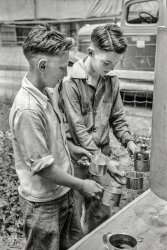
- Technocracy Inc.: 1939
- August 1939. Josephine County, Oregon. "New sign, erected seven years after Howard Scott talked of a survey of ... Posted by Dave - 02/27/2014 - 2:05pm -
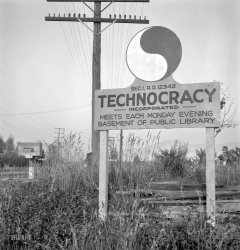
- Fresno Fruit & Honey: 1915
- ... fruit harvest in California from the south in spring to Oregon in the fall. I started out trucking (hand truck) lug boxes of pears to ... Posted by Dave - 11/18/2015 - 11:52am -
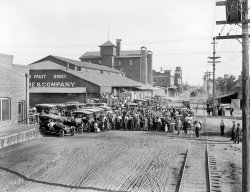
- Tiny House: 1939
- August 1939. "Josephine County, Oregon, near Grants Pass. A row of shelters like this for hop pickers' ... Posted by Dave - 04/10/2017 - 3:44pm -
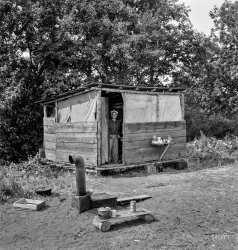
- Passageway: 1944
- ... thought when I scrolled down to the picture. Growing up in Oregon, my friends house had one. We always played in the breezeway.
Defend ... Posted by Dave - 08/30/2012 - 11:03am -
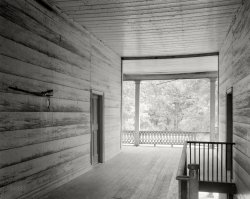
- Little Oklahoma: 1939
- ... I live near the WA/OR border and see plenty of cars with Oregon plates living in my neighborhood--and I have a few "get a Washington ... Posted by Dave - 06/15/2018 - 12:55pm -
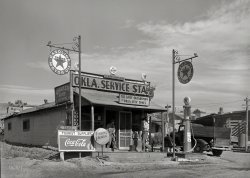
- Picnic in the Park: 1939
- August 1939. "Grants Pass, Oregon. 'California Day.' A picnic in town park on the Rogue River. Hot summer ... Posted by Dave - 05/25/2015 - 1:09pm -
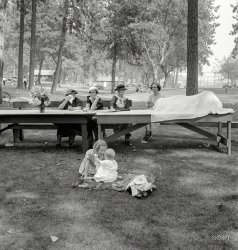
- And Away We Go: 1936
- ... of North Dakota. Family leaving drought-stricken farm for Oregon or Washington." Medium-format nitrate negative by Arthur Rothstein for ... Posted by Dave - 08/03/2012 - 12:47pm -
![And Away We Go: 1936 July 1936. "Drought area of North Dakota. Family leaving drought-stricken farm for Oregon or Washington." Medium-format nitrate negative by Arthur Rothstein for the Resettlement Administration. View full size.
Not a 'flivver' (Model T Ford)In fact, it looks pretty substantial, if a bit time-worn. But what is it?
They were going in that old flivver?I hope there was a better car out of view on the right. That one looks as if it couldn't even make it to the nearest general store.
[Rothstein felt that showing the butler packing the Duesenberg would spoil the effect. - tterrace]
That old flivvverMost were lucky enough to have an old flivver. Some had to walk with what they could carry.
BTW... tterrace - loved your comment.
(The Gallery, Arthur Rothstein, Cars, Trucks, Buses, Dust Bowl)](https://www.shorpy.com/files/images/SHORPY_8b28124a.thumbnail.jpg)
- The Cat in the Hat: 1939
- ... farms of the 1930s Dust Bowl to California, Oregon, Washington and the South. The captions are hers.
I love this ... Posted by Dave - 07/05/2009 - 2:41am -
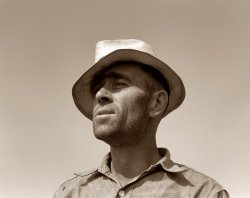
- The Dalles
- ... similar to the recent photo of Native Americans fishing in Oregon. Free viewing to see the 3D isn't difficult and worth doing to get the ... Posted by 3dfoto - 02/14/2022 - 2:39pm -
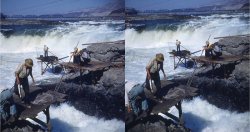
- Now We're Cooking With Gas!
- ... harder I scrolled through the OCR text of the Roseburg, Oregon newspaper article (the second link from Dave's search), and read that ... Posted by Dave - 05/03/2017 - 10:48am -
![Now We're Cooking With Gas! Columbus, Georgia, circa 1948. "Kitchen display -- Tappan stove." 4x5 inch acetate negative from the Shorpy News Photo Archive. View full size.
Warmed-Over MemoriesI grew up with that same Tappan stove. Was happy to find that name on the cooktop and double ovens here when I moved in.
Easy WhirldryA small portable washing machine.
[The Stove People don't know what they're missing. - Dave]
Google even harderI scrolled through the OCR text of the Roseburg, Oregon newspaper article (the second link from Dave's search), and read that it's an Easy Whirldry Washer:
https://www.google.com/#q=%22whirldry+washer%22
Plenty of hits on that; even a recently uploaded (2011) YouTube video of one in operation - in color!
What's in the Box?Can anyone make out the label on the box to the left? It looks like it says "New! All Purpose Whirlday Washer" - it's that word Whirlday - a google search comes up empty - that's what it looks like but that doesn't sound right. Its certainly Whi something something day though.
[Maybe you're not Googling hard enough. -Dave]
Know Them WellTappan stoves were made in my hometown of Mansfield, Ohio. Stovemaking started there in the 1800's. My great-grandfather was a patternmaker for one of the local stove companies in the late 1800's.
Betty BrownWas Betty Brown the name of the store or the new owner? I wonder what happened to the middle finger of the man in the back!
[She seems to have been the Betty Crocker of Tappan. -tterrace]
(The Gallery, Columbus, Ga., Kitchens etc., News Photo Archive)](https://www.shorpy.com/files/images/SHORPY-kit006.thumbnail.jpg)
- Good for Life: 1942
- July 1942. "Nyssa, Oregon. Farm Security Administration mobile camp. Soda pop is delivered at the ... Posted by Dave - 03/23/2016 - 1:21pm -
![Good for Life: 1942 July 1942. "Nyssa, Oregon. Farm Security Administration mobile camp. Soda pop is delivered at the camp for Japanese-Americans." Medium format nitrate negative by Russell Lee for the Office of War Information. View full size.
Summer jobMy summer job for four years in high school and college was working in the local Coca-Cola bottling plant, loading and unloading trucks like this one. There were no high-loaders or lifts, it was all done manually. To load a row of cases in the top rows, you had to climb up the side of the truck and push with your foot, since the row was too heavy to push by hand (at least for me). To unload empty cases, you could usually push the row by hand, but you still had to climb the side of the truck to grab them, depending on the height of the truck and how tall you were. Then, after unloading, all the empty cases had to be sorted by hand: all the Coke bottles in separate cases, all the Pepsi bottles in others, etc. Sometimes you'd find "strange" things in a returned empty bottle, e.g., a dead mouse or a cigar. One of the job's benefits was free Coke, all you wanted, and you soon learned that not all Coke tasted the same. The best was "post mix", the syrup used in fountains, where the syrup and carbonated water were mixed on the spot. Next best was "pre mix", where the syrup and water were pre-mixed in large metal cans, for businesses, county fairs, etc. The last was regular bottled Coke. This of course was in the days when Coke contained cane sugar, not high-fructose corn sugar. I thought I had the best summer job in town.
My First Impression"How come you're not in the service, mister?"
[Answered here. -tterrace]
Glass bottles = best tasteThe oldsters among us will know that those old time glass bottles, despite their inconvenience, gave one the best burst of flavor one could receive from a bottle of soda without the metallic tones of aluminum or the chemical betrayal of plastic. I fondly recall that at large summertime picnics usually put on by community groups, religious and ethnic clubs when I was a child, we always looked forward to the individual glass bottles of frigidly cold, fruity, delightful flavors and colors seen in those huge galvanized tubs containing vast amounts of crushed ice and nestled within that ice, like jewels, were tantalizing glass bottles of vivid lime green, bright orange, red cherry, purple grape, root beer and other tempting choices to enjoy with one's hot dog or burger. Since my siblings and I were always expected to share a single quart bottle when we were at home, at these special affairs we would each get our very own and would often drink ourselves silly. There really is something sensory and unique about a crystal clear, frigid, refreshing flavor from a glass bottled beverage on an oppressively hot, sweaty summer afternoon. Just another memory from the "long-ago" that will never come again.
Soda pop is deliveredThen empties are picked up and loaded.
Before there was a dosage recommendationIn later years, Dr Pepper eliminated the 'period', and the tag line became 10 - 2 - 4.
Those were the optimal times for the beverage.
(The Gallery, Cars, Trucks, Buses, Relocation Camps, Russell Lee)](https://www.shorpy.com/files/images/SHORPY-8c32512a.thumbnail.jpg)
- Baby on Board: 1939
- ... truck at the Farm Security Administration camp at Merrill, Oregon. View full size. Photograph by Dorothea Lange.
Re: Reflection ... Posted by Dave - 09/07/2011 - 9:54pm -
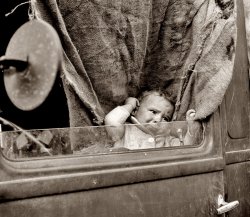
- Woman With Refrigerator
- A photo from my wife's family. Probably shot in Oregon. From the 1940s or 50s judging from the refrigerator.
(ShorpyBlog, ... Posted by Bruin - 02/03/2022 - 7:47am -
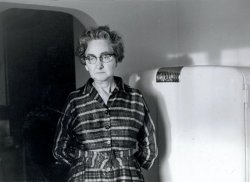
- Young America: 1941
- ... "Kids' race at the Fourth of July celebration in Vale, Oregon." Acetate negative by Russell Lee for the Farm Security Administration. ... Posted by Dave - 10/18/2018 - 11:54am -
![Young America: 1941 1941. "Kids' race at the Fourth of July celebration in Vale, Oregon." Acetate negative by Russell Lee for the Farm Security Administration. View full size.
Winners! Shoeless is best! If I recall my vintage catalog research well, shoes at the time mostly came with leather soles, in addition to leather uppers. With certain exceptions, like boots for barn wear or inclement weather, which were of course rubber. Leather soled shoes would be much too slick to run in, when what you're running on is dry dirt, therefore, stocking feet - for which you'll certainly get a scolding when your mother finds the condition of the "soles" of your socks! - or better yet, bare feet, are surely the way to go!
[Another exception would be the rubber-soled sneakers worn by zillions of boys. - Dave]
WinnersBarefoot seems to be the way to win. Stocking feet seems to be doing well also. Who needs shoes!
Nice to see that the race is one class and not split between boys and girls or between ages. Of course, don't know if they have separate prizes but at least it is one race.
Fit bunchNot a lot of body fat in the group.
Chalk one up for the girls.They seem to be holding their own among all the boys.
Boy on leftNever run a race without your Stetson on.
(The Gallery, July 4, Kids, Russell Lee, Small Towns, Sports)](https://www.shorpy.com/files/images/SHORPY-8c01698a.thumbnail.jpg)
- The Drifter: 1912
- ... boating/floating down the Willamette River from Eugene to Oregon City. Had to make sure to paddle quick to avoid the ferries at Buena ... Posted by Dave - 12/01/2015 - 11:45am -
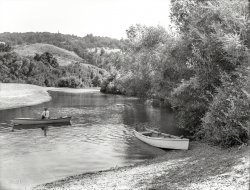
- Rotorua Cadillac: 1938
- ... least one of these used to run as a bus between Portland Oregon and Seattle Washington. I saw it for sale about two decades ago, luckily ... Posted by Dave - 01/03/2014 - 9:59am -
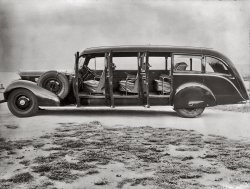
- Fruit Tramps: 1936
- ... in southern California and going through Napa, Medford Oregon and north to Washington. Some had tents and some pulled small house ... Posted by Dave - 08/12/2012 - 12:37pm -
![Fruit Tramps: 1936 July 1936. Yakima, Washington. "Fruit tramps from California who have come to the Yakima Valley for apple thinning." Medium-format nitrate negative by Arthur Rothstein for the Resettlement Administration. View full size.
TrampsI worked in pear packing sheds in Newcastle California in the late 40's and early 50's to earn spending for the school year. I met many people who followed the fruit starting in southern California and going through Napa, Medford Oregon and north to Washington. Some had tents and some pulled small house trailers. They worked very hard, and they were pleasant to work with. Most were older people supplementing their Social Security.
What Is It?I'd swear that's a Model A Ford, but the radiator badge defeats me completely. Some sort of aftermarket overlay, a political protest or something? Or am I just wrong about the car being a Ford?
[California State Automobile Association badge. - tterrace]
Vehicle IDOkay, this roadster screams 1929 Model A Ford - i.e. bumpers, wheels, radiator shroud, general body shape, Ford oval in headlight glass, etc. But the emblem on the shroud is clearly not the Ford Oval. What gives? Can you do a closeup and shed some light on this mystery?
[See comment below. Also, here's a restored 1929. - tterrace]
(The Gallery, Arthur Rothstein, Cars, Trucks, Buses, Great Depression)](https://www.shorpy.com/files/images/SHORPY_8b27964a.thumbnail.jpg)
- Daddy's Little Farmer: 1939
- ... of the children. Warm Springs district, Malheur County, Oregon." Photo by Dorothea Lange. View full size.
On the Banks of Plum ... Posted by Dave - 03/14/2013 - 10:48am -
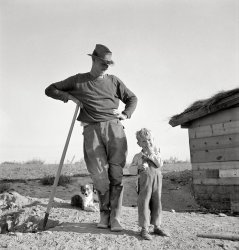
- Transplant: 1939
- ... this farmer ever had. Near Ontario, Malheur County, Oregon." Photo by Dorothea Lange for the Resettlement Administration. View ... Posted by Dave - 03/16/2013 - 11:31am -
